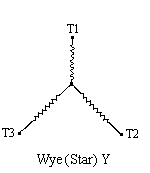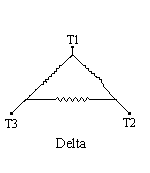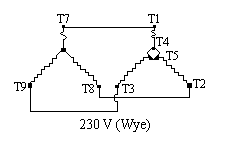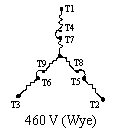In order to understand the wye-delta motors and wye start delta run motors, we should discuss motor connection and starting terminology as applied to three phase motors. The simplest and most economic way to start a three phase, squirrel cage, induction motor is with a full voltage starter. This starting method is referred to as:
Full voltage starting or
Across-the-line (ATL) starting or
Direct-on-line (DOL) starting
A motor designed to operate at a single voltage requires only three leads and is suitable for full voltage starting. The internal connections of the motor coils may be wye (Y) (also known as star (A) or delta ( ). This type of motor requires no connection diagram because the electrician simply connects the three motor leads (which may be labeled T1, T2 and T3) to the respective starter terminals, which connect to power supply lines, L1, L2 and L3. See the figure below for the connection schematics.
|
|
|
Many OEM´s and most distributors like to stock motors that may be used with various power supplies. For this reason we find many motors rated for dual voltage. The most common domestic motor in NEMA frames is the 9 lead, dual voltage motor rated 230/460 volts. Note, the voltage ration is 1:2. For 230 volt operation, the coils are connected in parallel; for 460 volt operation, in series (see the schematics below).
|
|
|
 |
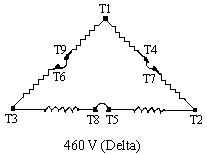 |
Many foreign countries have 380 volt and 220 volt, 50 Hertz power supply; it would therefore be desirable to stock motors with such voltage combinations. It so happens that the relationship between a delta connected motor and a wye connected motor is 1 3 or 1:1.173 or 220:380 volts as shown on the following schematics. This type of motor has six leads identified as shown below.
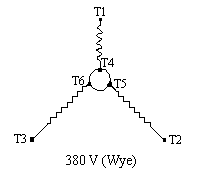 |
The above connected motor is also suitable for reduced voltage type starting known as wye-delta or star-delta on 220 volt power supply. In the starting mode the special magnetic starter connects the motor coils in wye. Note above that in wye connection, the motor should see 380 volts to develop full load torque; but, since we only apply 220 volts, the motor will only develop 33% torque and will draw only 33% of the normal starting current. After a predetermined time, the starter changes the motor coils from wye to delta, which is the full voltage running connection.
Note that in the following figure one of the "S" contactors is shown dotted since some starter manufacturers use only two instead of three contactors. Also note that a 3/50/220/380 motor could also be called a 3/50/220 motor wye-delta start.

 |
1M & "S" Contactors Close During Start |
 |
1M & 2M Contactors Close During Run, "S" Contactors Open |
It is not always clear what a customer wants. A typical request for a three phase motor may state that the power supply is 50 Hertz, 220/380 volts. This generally means 380 volts, three phase/220 volts, single phase.
If the request is for a 3/50/220/380 motor, the customer may want to use the motor on 220 volt power supply with a wye-delta starter. He may also sell the motors to different countries having either 220 volt or 380 volt power supply.
Occasionally, we come across requests for 3/50/380/660 motors. We cannot furnish such a motor in NEMA size ratings unless the customer wants a 380 volt motor suitable for wye-start, delta-run. The reason why we cannot furnish such a motor is because our random wound insulation system used in NEMA frame motors is only approved for 600 volts, plus 10%. According to a chart titled, "World Electricity Supplies:, there are only two countries, Finland and East Germany, which have a 660 volt power supply. There are also some power plants which tend to use a 660 volt distribution for their in-plant equipment.
There are also some distributors or OEM´s who like to stock dual voltage wye-start, delta run motors such as 3/50/220/440. This type of motor requires twelve leads and is connected parallel wye-delta for low voltage and series wye delta for high voltage. See the figure below.
 |
 |
| 220 Volt | |
 |
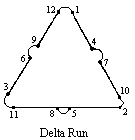 |
| 440 Volt | |
Part Winding. This method used only a portion (usually one-half, but sometimes two-thirds) of the motor winding, increasing the impedance seen by the power system. It is to be used only for voltage recovery, and must not be left on the start connection for more than 2 to 3 seconds. The motor is not expected to accelerate on the start connection, and may not even turn.
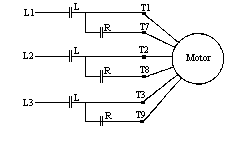

Part Winding Start
Starting Characteristics:
- Starting current is 60-75% of normal, depending on the specific winding connection.
- Starting torque is very low (may not even turn the shaft).
- Winding heating is very high on start connection.
Applications:
Where power system has automatic voltage recovery and normal inrush would cause unacceptable voltage dip. Should not stay on start connection more than 2 to 3 seconds.


